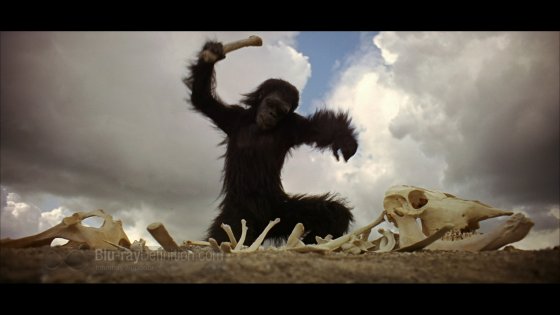After the satirical DR STRANGELOVE Kubrick had developed a taste for science fiction. He consequently contacted Arthur C. Clarke, who had a reputation as a scientific fiction writer, i.e. space age freak and cargo cultist, sci-fi being the religion of a technological society.
In its most primitive form, it is of course pure Blavatsky, superior intelligences guiding Man to higher planes of existence, somewhat more intelligently formulated by Nietzsche, but often leading to the kind of pseudo-Darwinism finding expression in ideas of “historical evolution” (which is of course a contradiction in terms) and “personal development”, and ultimately of “inferior” races, cultures and individuals. Unsurprisingly, both of these notions – that Man’s future lies in space, and that he is, consequently, under surveillance – are to be found in the finished movie, accounting for its strange blend of hardware and mysticism.
Working from the short-story “The Sentinel” about a “fire-alarm” buried on the moon in the dawn of time by extraterrestrials being set off, thus informing them that Man has “left his cradle” (to quote one of Clarke’s own favourite metaphors), the collaborators soon went separate ways without leading to “irreconcilable artistic differences”, Kubrick simply making his movie, and Clarke writing his silly novel. Whereas Clarke was eager to conceal the mystical and religious leanings of the plot, Kubrick revelled in them.
To him, the aliens were gods, pure and simple, watching over his Ulysses, ignoring the conflict that makes the Odyssey exciting and following the Fascist credo of Olympus as a totalitarian state. Consequently, they are never seen, something for which pseudo-scientist No. 1, Carl Sagan, was quick to take credit.
Still lacking an actual plot, Stanley opted for a middle-section pitting the astronaut against an artificial intelligence in the shape of the ship’s computer. Athena (later renamed HAL, formed by the preceding letters in IBM) reacts to the illogical proposition of not informing the crew of the purpose of the mission with a mental breakdown, finally killing off most of it out of self-preservation, thus ironically making the humanity and not the inhumanity of machine intelligence the danger.
Apart from this intrusion, the movie is basically a slideshow. Stan systematically weeded out all of the explanatory narration and most of the dialogue, even cutting the visual exposition to the bone, among other things resulting in the famous match-cut from bone to spacecraft, leaving out a couple of million years.
This was originally intended to be a nuclear weapon, but the idea was discarded on the grounds of been there, done that. Still, the somewhat cynical observation that Man owes his humanity to the development of weapons remains, the triumphant initial bars of ALSO SPRACH ZARATHUSTRA extolling Cain’s discovery.

What also remains is the famous waltz ending with the ferry penetrating the pirouetting space-station and the interiors of the giant spaceship. These images are still the most technically impressive in the history of the cinema, which, incidentally, saves them from being immensely boring.
Compared to these sequences, the other special effects are a bit of a letdown, from the monkey-suited extras (apparently, the offspring of primeval Man were chimpanzees) to the “star gate” suspiciously resembling the subway complete with travel posters, advertised as “tripping without drugs” by people, who obviously had no idea what they were talking about. Of course, in 1968 – I was eighteen, when it premiered – on a 100 ft. wide screen with deafening six-track stereophonic sound, the effect was tremendous!
The decision to score the long stretches of film that had no dialogue with classical music – and refraining from scoring those that had – further serves to separate the realistic scenes aboard the space vehicles from the “visionary”. Alex “Cleopatra” North must have been a bit miffed to discover that the entire score commissioned by Kubrick had been jettisoned!
Predictably, it was one of those groundbreaking movies, which are ridiculed by critics and hailed as masterpieces a few decades later. Especially science fiction writers and fans were harsh in their criticism, the sci-fi community being basically sectarian.
In the final analysis, 2001 – A SPACE ODYSSEY is of course a masterpiece as well as a folly, at once deeply emotional in its conception of a transcendental destiny for the human race and simpleminded in its lack of imagination, when it comes to conceiving its implications. Everything is colossal about this movie (without involving the Roman Empire), even its two major copouts: First that we are never informed of either the identity or intentions of the guiding super-race in making killers and explorers of us, and secondly Stan announcing that “we are free to speculate”.
Obviously, he had no idea what he was doing. Perhaps that’s the real key to its success.
And that’s all, folks! Vil man have mere, er det den ultimative guide til gysere og science fiction film, man skal have fat i, 800 tættrykte sider til den latterlige pris af 500 kroner! Den kan bestilles på
Benyt gerne bestillingsformularen! Vi ses i filmens forunderlige underverden – To a World of Gods and Monsters!


